
Bullet and Splinter Wound Care Page Menu: 1 2 3 4 5 6 7 8 9 10 Next>>
Bullet and Splinter Wound Care in the Golden Age of Piracy, Page 9
Step 5: Remedy Complications
Just as they did with simple wounds, period surgeons talked about a wide variety of complications that could occur in gun shot and large splinter wounds. Richard Wiseman has one of the most extensive lists: "The Symptoms attending Gun-shot are Pain, 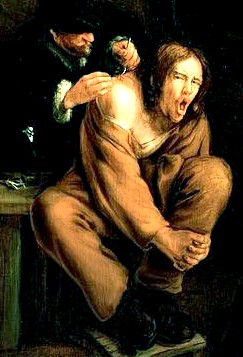
Artist: Garrit Lundens
Surgeon Treating a Shoulder Wound (1649)
Phelgmon [uncontrolled inflammation] Erysipelas [severe redness and swelling of the skin], Fever, Delirium, Syncope [loss of consciousness], Gangrene, Convulsion, and Palsie."1 As if that weren't enough, he lists 'accidents' which can accompany bullet wounds with fractures that includes many of the same symptoms, adding hemorrhaging and sphacelus2, which at this time was considered the second stage of gangrene or death of the part which then required removal.
Ambroise Paré also listed a variety of 'grevous symptoms' that could accompany gunshot wounds including "pain, Defluxion [large flows of fluids from the wound such as uncontrolled bleeding], Inflammation, Aposthumation [abcesses], Convulsion, Phrensie [madness], Palsie, Gangrene and mortification [sphacelus], whence lastly death ensues."3 With the exception of the abscess and frenzy, these are the same as the complications listed by Wiseman.
Expanding upon the idea of the abscess, Paré explains that such wounds "often degenerate into virulent, eating, spreading, and maligne ulcers, which cast forth a stinking and carion-like filth, whence the part gangrenates, unless you withstand them with Ægyptiacum and other acrid medicins"4. The use of such medicines in these cases was discussed previously.
Sea surgeon John Woodall presents a much simpler picture.
The most notable differences I have ever observed twixt a wound made with Gunshot, and an other contused wound, is onely a steeling [probably here meaning 'a limited amount'] flux [flow] of bloud, and a dangerous disposition to a Gangrene, which two accidents warily prevented the Cures of such wounds differ nothing from ordinary wounds contused.5
As Woodall suggests, most of the complications listed by Wiseman and Paré are covered in some detail in the complications for simple wounds. Rather than repeat the suggestions for treating them here, the reader is referred to the section of the simple wounds article on remedying complications. However, two of these complications are not discussed in the simple wounds article: erysipelas and gangrene. Let's look at how they were treated.
1 Richard Wiseman, Several Chirurgicall Treatises, 1686, p. 436; 2 Wiseman, p. 409; 3 Ambroise Paré, The Workes of that Famous Chirurgion Ambrose Parey, 1649, p. 315; 4 Paré, p. 324; 5John Woodall, the surgions mate, 1617, p. 142
Step 5: Remedy Complications - Erysipelas
An erysipelas is an acute infection of the epidermis or upper layer of the skin which appears as a rash. It is sometimes also called St. Anthony's Fire or Ignis sacer (Latin for 'holy fire'). Richard Wiseman explains that the rash is "a shining yellowish colour mixt with red here and there vehement, heat, with a pricking pain blistering the Skin"1. Although he doesn't describe its appearance, sea surgeon John Moyle says that "it is fiery hot and painful and hath a malignant quality in it"2.
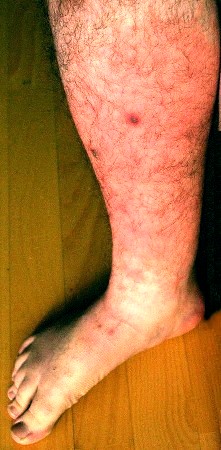
Artist: Tommi Nummelin
Erysipelas of the Leg
Moyle suggests that an erysipelas can deepen. "It seizeth a Musculous part, it tumifies [swells] exceedingly, but begins not very deep at first, but near the skin, but afterwards eats deeper and wider, and becomes great and lamentable."3 However, this sounds more like the formation of a tumor than an upper skin inflammation, which is how it is described in modern medicine.
Wiseman's assessment of the problem agrees with the current view, noting that the problem "affects the superificies [surface] of the Skin with a shining, pale, red or citron colour, without Pulsation or circumscribed Tumour, spreading from one place to another."4 Like Wiseman, Moyle notes its creeping, stating, "I have known when it hath grieved in one place, that there hath been a Plaster of Methridate laid thereon, and the raging humour hath removed to another place, not far off the first."5
They both agree that St. Anthony's Fire has humoral causes. Wiseman directly ascribes the problem to one of the bodily humors, stating that "[a]n Erysipelas is generated of a hot Serum in the Bloud"6. He says that while this serum comes from the blood, it is not the blood itself. (While most sources recognize the four basic bodily humors - blood, phlegm, black and yellow bile - we can here see that the idea of humors was rather flexible, applying to all sorts of fluids in the body.) He expands upon this idea:
The Humour it self simply considered is very thin and sharp, much affecting the Pores of the Skin, in which it usually lodgeth… they being covered with a Cuticula [tough outer covering], whose density hinders transpiration [release through sweating], from whence pain and redness arise; and oftentimes other Humours are invited thither, so that the Tumour enlargeth, and becometh compound.7
Wiseman thus separates the tumor from the erysipelas, suggesting that any accompanying tumor is caused by humors other than what caused the rash. Moyle does say that the “Tumour is an effect of that fiery and bubbling humour and Choler, and seizeth sometimes on one part, and sometimes on another, of the Body or Limbs."8 However, he doesn't suggest that the rash is caused by the same humor as Wiseman, apparently believing it is an advanced stage of the problem rather than a complication arising from it.
1 Richard Wiseman, Several Chirurgicall Treatises, 1686, p. 35; 2 John Moyle, Chirugius Marinus: Or, The Sea Chirurgeon, 1693, p. 129; 3 Moyle, p. 129-30; 4 Wiseman, p. 34; 5 Moyle, p. 129; 6,7 Wiseman, p. 34; 8 Moyle, p. 129
Erysipelas - Humor-Based Cures
Being a humor-based health problem, the cure of an erysipelas 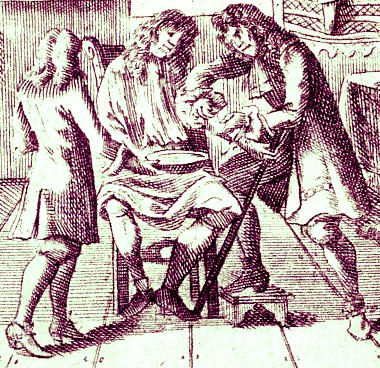
Artist: Wolf Helmhardt von Hohberg - Bleeding a Patient (1695)
naturally has several suggested humor-based cures. Both Richard Wiseman and John Moyle agree that a patient with an erysipelas should be let blood. Wiseman notes that all surgeons agree on this point.1 Moyle (whom you will recall says the problem humor is choler) says that the surgeon "must let Blood plentifully, and purge Choler effectually"2. Purging Blood to remove choler sounds odd, but, as explained earlier, Ambroise Paré explained that the body could transform a part of blood into choler.3 Moyle goes on to advise the surgeon, "let bleeding be repeated often."4
Wiseman also advises purging the digestive system when treating this problem. He explains when "the Erysipelas be simple, and but in the Skin, we are then by Purgations only to evacuate the redundancy of Humours, and prevent the ebullition [bubbling up] of Choler."5 He here appears to be referencing his earlier comment that an erysipelas could attract other humors to the rash site. He prescribes against harsh purgatives, preferring 'lenients', such as:
cassia [fistula][a diuretic], tamarinds[a laxative], manna, cremor tartar [cream of tartar][diuretic], rhubarb. [laxative] &c. in Whey, or in Decoctions of Barley and opening Roots [asparagus, fennel, kneeholm/butcher's broom, parsley and smallage/celery], with Syrups e cichor. cum rhubarb. [syrup of chicory with rhubarb] and de rhubarb. de ros. solutiv. also the Elect lenitivum, diacathhol. diaprun. e succo ros.6
He does not limit his 'puragations' to diuretics and laxatives, however. "Clysters [Enemas] are also most proper in these Diseases."7 He also says that once the bowels are empty, the patient can be treated by emetics, medicines which cause vomiting, "if the Erysipelas be in the neather [lower] Parts."8
Wiseman mentions other mechanical treatments
Photo: Augustus Binu - Pomegranate Fruit
(besides bleeding) aimed at removing unwanted humors from the site of an erysipelas. "[Y]ou may make Revulsion [moving humors away from a part of the body] by Friction [rubbing], Cupping, &c."8 He also notes that an "Erysipelas which goeth off by Transpiration [sweating] is best."9 He does not seem to be referring to induced sweating, however, rather indicating that erysipelas which goes away accompanied by a natural sweat is preferable.
An indirect facet of humor theory involved the patient's diet. Wiseman gives very specific recommendations on this.
Their Diet ought to be… very sparing, Grewels [gruels], Panadoes [a sort of gruel made with bread], and Chicken broth, with cooling Herbs; their Drinks, Ptisans [A nourishing drink, often made of sweetened barley-water], Barley-cream, Emulsions [oily medicines mixed into non-oily liquids], and Juleps made of distill’d Water, as aqu. borrag. [borage water] endiviæ [endive water], acetosæ [sorrel water], lactucæ [lettuce water], portulacæ [purslane water], &c. cum [with] syr. e succo [syrup of chicory] citr. [syrup of quinces] limon. [syrup of lemons] granat. [syrup of pomegranate] Rub. Idæi [syrup of red irises], violar [syrup of violets], and the like; avoiding Wine in these Diseases.10
Wiseman gives some other recommendations loosely associated with humorism. "Rest and Quiet of mind is here to be desired"11. He advises to the surgeon to take the patient's body type into account, since certain body temperaments were thought to contain an abundance of certain humors. "In the Cure of an Erysipelas you are to consider the Habit of body; for whilst it abound with bilious Humours"12.
1 Richard Wiseman, Several Chirurgicall Treatises, 1686, p. 35; 2 John Moyle, Chirugius Marinus: Or, The Sea Chirurgeon, 1693, p. 129; 3 Ambroise Paré, The Workes of that Famous Chirurgion Ambrose Parey, 1649, p. 11; 4 Moyle, p. 130; 5 Wiseman, p. 35; 6 Wiseman, p. 35-6; ,7,8 Wiseman, p. 36; 9,10,11,12 Wiseman, p. 35
Erysipelas - Medicine-Based Cures
Several medicines were prescribed to combat erysipelas by surgeons during the golden age of piracy. The majority of these medicines were for topical applications and foments (bathes).
Erysipelas on the Arm
Sea surgeon John Woodall recommended two simple topical medicines. The first was wine vinegar, which he explained "is a precious help, as also made into a sirupe with hony, then tearmed Oximell, or with sugar, then tearmed Oxisaccarum"1. The second was camphor, which he said "refrigerateth [cools] and calefieth [warms]... [and] cureth Erysipelas or St. Anthonies fire"2.
Cooling medicines were not always considered appropriate, however. Fellow sea surgeon John Moyle warned that when the rash developed into a tumor, "you are not to cool this Tumour too forcibly with your externals [topical medicines], for by that you might cause a Gangreen"3.
Richard Wiseman only recommends cooling medicines conditionally:
If it [erysipelas] arise from an external Cause, you may safely apply Refrigerants without an preceding Evacuation [purging the body], because the Disease took its original merely from the disaffection of the Part, whether it was from the scorching heat of the Sun, sharp Medicines, Contusion, or Fracture, &c. and not from the peccancy of the Humours.4
Note that several of Wiseman's externally caused problems are probably not an erysipelas at all. The first two sound like reactive burns caused by the sun or caustic plants, respectively. However, it is the medicines Wiseman uses to treat externally caused erysipelas that are of interest to us since the third and fourth problems are directly related to gunshot and large splinter wounds.
Wiseman lists an extensive number of medicines he feels are appropriate in treating an externally caused erysipelas, explaining that those 'generally prescribed' are of cooling and moistening qualities. Like the body itself, plants were thought to have one or more humoral qualities: cold, hot, dry and moist. (For more information on the humoral qualities of plants, see Medicine Theory: Galen's Humors in the dispensatory article.)
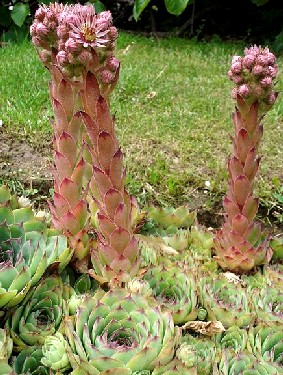
Photo: Francois Van Der Biest - Sempervivum
In listing them, Wiseman divides the appropriate medicines into the traditional two types: simples (raw ingredients) and compounds (mixtures of raw ingredients & chemical medicines). For simple medicines, he recommends: "umbilicus Veneris [Umbilicus rupestris or navelwort], polygonum [knotweed], plantag[o]. [plantain], trifolium palustre [meyanthes or buckbean], portulac[a]. psyllium, sempervivum, solanum"5. Wiseman says the compound medicines are 'of various sorts', but lists the required ingredients for only one of them:
Rx. cerussæ [white lead] {8 ounces} lithargyr. auri [litharge of gold] {4 ounces} mucilage. sem. psyllii [psyllium seed], cydon. extract. [quince extract] in aq. solani [in solanum water], succi. solani [solanum juice], umbilici Vener. [umbilicus rupestris or navelwort] {or each 3 ounces} aceti cochl. [horseradish?] {4 ea.} ol. ros. [oil of roses] & myrtill. [oil of myrtle] {of each 1/2 pound} sevi vitulini [calf suet] {4 ounces} coq. ad succor. consumpt. [boil until the juice is consumed] deinde adde [then add] thuris pulv. [powdered frankincense] {10 drams} ceræ q.s. [as much wax as is sufficient to] fiat Ceratum [make into a cerate].6
You may notice that this concoction contains many of the simples recommended by Wiseman. He also says the surgeon can use ceratum Galeni (Galen's cerate - cold cream) or unguent nutritum with a third part of populeon (unguent of poplar) added to it.
While Wiseman is concerned with medicating the rash, Moyle's medicines are focused more on dealing with the ulcer that the rash can produce. When a tumor occurs with the erysipelas, the surgeon is to make both a medicine to be drank and a topical medicine for application to the ulcer. 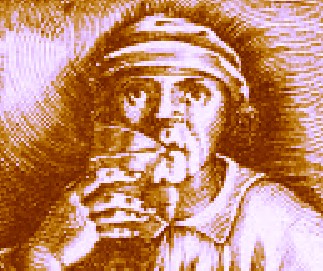
Photo: Jan Van Der Biest - Patient Drinking Medicine
The ingested medicines which can be used (with paragraph breaks added for clarity) include:
Rx. Electuar e succo Rosar. {1/2 ounce} Pulv. [powdered] Rhabarb {1/2 dram} misce [mix together], f. Bolus. [make into a bolus] Or,
Rx. Rhubarb sliced {1 dram}, infuse it in Aq. Cicchoriæ [succory water]{4 ounces}, deinde Colat [then strain], deinde adde [then add], Syr Ros. solutiv. {1/2 ounce} f. Haustus. [make into a haustus or draught]
Let the Patient sometimes take the Bolus, and at other times the Haustus, until the humour is overcome, every other day7
The topical medicine Moyle suggests is Oil of Roses made with olive oil with Unguent of poplars and white camphor possibly being mixed into the oil. It can then be "spread the same on a fine Cloth" and applied.8
It is worth mentioning that a rash arising from a contusion or bruise accompanying gun shot and large splinter wounds would probably not be viewed as an actual erysipelas by a modern doctor. It would be more likely considered an inflammatory reaction resulting from improper care of the contusion. However, the period surgeons under study did not make this connection. Even if they had, they probably would have advised a similar course of treatment.
1 John Woodall, the surgions mate, 1617, p. 65; 2 Woodall, p. 110; 3 John Moyle, Chirugius Marinus: Or, The Sea Chirurgeon, 1693, p. 131; 4,5,6 Richard Wiseman, Several Chirurgicall Treatises, 1686, p. 36; 7,8 Moyle, p. 130

